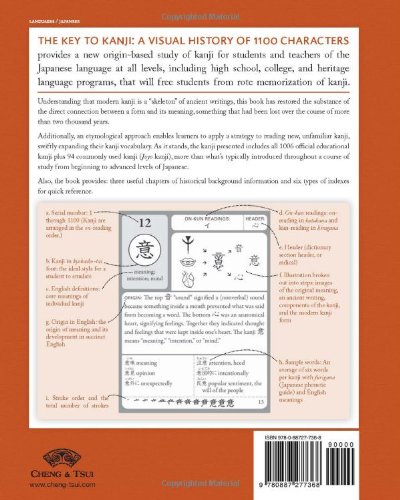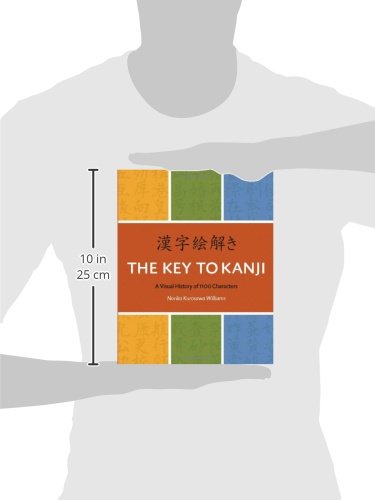



Full description not available
M**W
Yes! Visually Appealing; Accessible and Indispensable
Consistent work throughout the entire text. Lots of illustrations with as much historical information available. I have not read the introduction, through, yet, but I have followed the free online video series provided by the author. I have also read and successfully learned a few kanji in just a couple sittings, just by reading and paying attention to the stories within this book.(-- Visually imagining the stories and meanings of the parts of the kanji while seeing them/ their illustrations, saying their pronunciations out loud --they are in kana, please learn kana! --, writing them or drawing them out...Do what you can to engage with the text! Passive vocab takes forever! You only truly understand it if you can explain it!If you have trouble with engaging with reading, I recommend How to Read a Book by Mortimer J. Adler and Charles Van Doren. -- Ironically, there is an audiobook to that work, so don't worry.)I say, if you can afford it, get The Key to Kanji. It is clear that a lot of care went into its content. Most of it reads like a storybook, and its indexes are helpful for finding what you need. It even has a history of kana formation, in the front -- which was a pleasant surprise!The physical book has some heft to it and it has a nice cover with a visual description of its contents on its back.In regards to what I have read, in the introduction of this book, I wonder if schools really do use it in their classrooms. If they don't, I think they should. Honestly, the way of rote memorization (basically intensely trying to force a memory through repetition and nothing else. See: high school language classes from the early 2000s to mid 2010s having students rewrite vocab based only on definitions about 100 times a night...) is exhausting.Learn the real stories of the kanji! Historical context and stories do wonders for one's memory, in my opinion. If you do not already have a background living immersed in the Japanese language/ can understand it thoroughly without kanji... I think context (i.e.: history, pronunciation) is a must!If you are a visual learner, enjoy stories and or struggle with kanji, I say get this.I have been studying Japanese for a decade; and, aside from learning kanji in context, learning the truest (that can be stated) backstories of words (etymology) with visualization of their formation... Super useful, imo.If you are interested in the sound based research of kanji, however, though Noriko-sensei wrote about doing such research on that topic in The Key to Kanji (despite not putting said phonetic research within the Key to Kanji book itself, only having had mentioned having done such research, briefly . . . ) another author, Natalie Hamilton, wrote and made a visual compilation of her research on the subject: The Kanji Code. Though that book is an easy read and more compact, it is a bit more linguistics based. I say that one is for people past the beginner levels of Japanese learning.The accessibility level of The Key to Kanji, however, is definitely not super intense. I say if you are willing to put in the work and are patient with your mind, and are willing to learn about how you personally learn/ what works with you . . . you got this!For clarification, I am upper intermediate with my Japanese studies. I am also a self taught learner, (for over a decade. Yes, before Youtube and even the popularity of Myspace... I have gotten quite serious in my studies, recently, and have gone through my fair share of not so great study materials, lol... ).I say, nothing beats cultivating your passive and active learning, also cultural context is key to understanding a language. Don't forget grammar and the other language goodies.Be sure to find natives to speak to, and I HIGHLY recommend a tutor or language exchange partner. If you cannot afford one, please go somewhere like Reddit's Language Exchange forum or HelloTalk and practice internet safety! -- Be sure to offer teaching your language as well, if you go the free route. Try to find an exchange partner with similar interests. :D(If you need help on where to start with Japanese language learning, in general:Tofugu's website has amazing guides for where to start with things like learning Japanese, reading in the language, kanji, dictionaries, so on. (Most of the site is archived, so if it ever absconds from the face of the earth, check something like the Wayback Machine!)Be sure to be well rounded in your studies and start at an appropriate level!Also, please be wary of places that only seek to sell you things but never show you results/ have iffy research!Also, please know what your goals are. Find the stuff that works and works for you, and stick to them. More does not equal better!)100%: understanding that one does not know everything out the gate and also that native speakers are indispensable in the learning process really helps. (Be one with the ways of the student. ^^) Also, people are just people, cultures are different, and some things just don't work out, and that's okay!There are not a lot of English based works on Japanese that take the cultural Japanese mindset into mind, or that have such detailed historical research done on the topic Japanese kanji... So I really do say this book, The Key to Kanji, is pretty indispensable to me, personally.Finally, please be sure to support educators and creators when you can! Especially when they have helped you out! :3Thanks for reading and happy learning! :D
A**E
A must have for anyone who wants a strong understanding of Kanji
I used this book to study for the N2 Exam of the Japanese Language Proficiency Test (JLPT) this past year and found it absolutely amazing. Learning kanji as a unified system using it's etymology as apposed to blunt memorization or mnemonics is definitely the way to go.When I set out to begin studying for the exam I really wanted to deepen my understanding of kanji using a systematic approach rather just trying to "memorize" each one, as was the approach taught to me in my university Japanese classes. Anyone really looking to attain a high level of Japanese skill will soon find that the blunt memorization approach to learning kanji drops off in effectiveness rather quickly. This is partially because there are many kanji that contain similar radicals, and this makes distinguishing one kanji from another difficult if you don't understand why each radical is present and what they "mean". For example, there are multiple kanji with the same on-reading of han but each is used in very different words, and being able to distinguish between when each is used is crucial in order to read and write them effectively. Another reason is because in general learning things by understanding them as a part of a system is more effective than learning disparate facts at random. Learning random kanji via drilling flashcards can be a great supplement to a systematic understanding of kanji, but in my experiences that alone can't get all 1000+ kanji in the Kyouiku series or the 2000+ kanji in the Jouyou series to really "stick" into one's brain. For me blunt memorization caused a sort of snowball effect where I would forget old kanji after learning new one's, causing an ever-increasingly long series of review and relearning.So if you're tired of drilling flashcards or writing kanji over and over again only to forget them 3 months later, that's where this book comes in. The book begins with a historic overview of the Chinese origins of kanji, and from their breaks down the various categories that kanji can be placed into based on the way their radicals combine to form the overall unit. The book then goes on to give a breakdown of each kanji radical and their historic meaning(s) (which can vary as a result of the Japanese importation of the original Chinese character). Finally, you have the 1000 kanji that comprise the Kyouiku series of kanji, the series taught to Japanese children in elementary school grades 1-6. Each contains a thorough description of their radical composition and the overall meaning based on this, on and kun-readings, as well as proper stroke order and even a few example words. All of this topped with multiple VERY handy glossaries at the back for quickly finding the kanji you're looking for.Overall this book is an absolutely fantastic tool for learning kanji, with the only downside being that it doesn't cover the entire 2100 kanji comprising the Jouyou series. I myself would love for the author to make a companion book including the rest of the Jouyou kanji. Even still, for someone looking for a solid text to take you through the kanji all the way from beginner level to N2 level this book is a must have.
A**Y
A must have book for any student of Japanese
I have been studying Japanese for many years, and I have purchase many, many books on all aspects of learning the language. I've taken two years of college Japanese and numerous supplemental classes, and, I have to say, this is my favorite book on Kanji. It is a reference book, not a how-to-learn-kanji book. It can be used by any level of learner. It's written in a casual style that I find refreshing after reading, so many, "dry" books on Japanese. I have found learning the historical origin and construction of the Kanji characters to be not only fascinating, but also a good way to remember their meaning. Over the years I have returned to this book again and again. You will need other books, and one-on-one teaching, to master Kanji, but if you have any interest in the historical basis of Kanji, and you should, this is a must have book!
Trustpilot
4 days ago
1 day ago